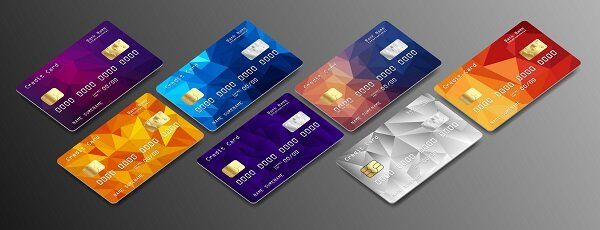How Much Credit Card Debt Is Too Much?

- In addition to not being able to keep up with your payments, being stressed out by your debt is a sign you have too much credit card debt.
- Credit cards have higher interest rates than many other types of loans.
- Proven strategies that can help you pay off your credit card debt and start fresh include debt consolidation and credit counseling.
Table of Contents
Credit cards are convenient. They might offer rewards for using them. They are convenient and make it easy to spend in-person and online. Credit cards can be a great way to pay for things but a terrible way to finance things. Credit card interest rates tend to be higher than those of other types of financing, and their low minimum payments can keep unwary consumers in debt for years, even decades.
So, how do you know when you have too much credit card debt?
The Problem With Having Too Much Debt
Let's face facts: Most Americans possess and increasingly rely on credit cards to pay for items on demand. According to Federal Reserve research, they are simple, easy, and quick to use. The average American household owes $6,270 in credit card debt today. And without discipline, that debt can become problematic.
Everyone gets in a little over their heads once in a while, and sometimes, charging a bill to your credit card really is your best option in the moment. That said, credit card debt can create new challenges over time.
Getting credit card debt relief is possible, and it's a great first step in taking control of your finances. There are several things you can try to put your debt behind you. But you always want to begin with education. That's where we'll start.
Let’s look at some key questions, like how do you know when you have too much credit card debt? And how do you take control of credit card debt so you can put it behind you?
How Much Credit Card Debt Is Too Much?
If you asked most people, the ideal amount of credit card debt is zero. We'd all like to pay off all our monthly bills in full every month. But sometimes, our budgets just don't allow that.
There's no hard line where credit card debt becomes problematic. If you carry a balance on your credit card, you'll owe interest (unless you’re in a special zero-percent promotion). But if you pay the balance in full the next month, it may not cost you that much extra, and it might not worry you. However, someone else in that situation might be really stressed out by the idea of carrying any balance at all.
Whether it’s problematic is ultimately about when the debt begins to negatively affect your lifestyle. If it's causing you a lot of stress, costing you more than you’d like to be paying on debt, or you're getting calls from debt collectors because you can't keep up with your payments, those could be signs that you’re out of your debt comfort zone.
9 Warning Signs of Too Much Credit Card Debt
Consider whether any of the following red flags apply to you:
Your debt-to-income (DTI) ratio is high.
You carry balances because you spend more than you earn.
Your cards are maxed-out, or close to it.
You make only the minimum payment on your credit cards.
Your credit score drops because you use a lot of credit.
You’re using new credit cards to pay old credit cards.
You’re using credit cards for cash advances.
You’re not able to make minimum payments on time.
Your credit card debt makes you anxious.
Warning sign #1: Your DTI is high
Your debt-to-income (DTI) ratio is a measure of how much of your monthly income goes to debts and housing. Add up your monthly debt and housing payments—credit card minimum payments, loan payments, mortgage or rent, etc.—and divide that number by your before-tax monthly income. Don't include living expenses like food or utilities in this calculation.
For example, if your monthly gross income is $5,000 per month, and your monthly debt payments amount to $2,500 per month, your DTI ratio is 50%.
Lenders prefer that your DTI ratio is 36% or lower when you apply for a loan. That tells them you can afford the payment on the new loan you want. Even so, it’s possible to be approved for a loan with a DTI over 50%.
A higher DTI means there’s less room in your budget and you may have too much credit card debt. That could make it harder to find extra money to pay down debt.
Warning sign #2: You carry balances on your cards because you spend more than you earn
Carrying a balance on your credit card might be your only option for handling an unplanned expense if you don't have an emergency fund. That’s okay. But the idea is to pay the balance down as soon as you can. If you can’t, or if your debt is going up each month instead of down, you might be spending more than you’re bringing in, leading to too much credit card debt.
Warning sign #3: Your cards are maxed out or close to it
Every credit card has a credit limit. The card issuer doesn’t allow you to spend more than this total amount. If you're approaching your limit on one or more cards, that could be a red flag that you have too much credit card debt.
Warning sign #4: You always make only the minimum payment on your credit cards
Credit card minimum payments are usually pretty low. They're often a small percentage of the total balance. As long as you pay this amount, the card issuer reports your account as being in good standing.
But minimum payments are designed to keep you in debt for a long time. The longer you owe, the more interest you’ll pay. If you’re only paying the minimum, you’re making very little headway against the debt. If your minimum payments are very high because your balances are very high, you might have too much credit card debt.
Warning sign #5: Your credit score drops because you use a lot of credit
Your credit utilization ratio is your credit card balance compared to your credit limit. It’s calculated for each card, and overall. For example, if you have a $1,000 credit limit and you charge $250, your credit utilization ratio for that month is 25%. Utilization is a major part of your credit score. Higher utilization tends to bring credit scores down.
A higher credit utilization ratio for a single month may not be too concerning. But a high utilization over time could mean that you have too much credit card debt.
Warning sign #6: You’re using new credit cards to pay old credit cards
Using new credit cards to pay off old credit cards only makes sense if you’re using a 0% introductory balance transfer offer and you have a plan to get rid of the debt.
If you’re moving debt around between credit cards because it helps you skip a payment now and then, you probably have too much credit card debt. This is a situation that might even call for expert debt help.
Warning sign #7: You’re using credit cards for cash advances
Many credit cards offer cash advances, which are convenient, short-term loans against your credit limit. But cash advances typically carry high interest rates. Also, there’s no interest-free grace period on a cash advance the way there is with most purchases. The debt begins accruing interest immediately.
A credit card cash advance could be a good short-term emergency solution to a cash crunch. It’s typically cheaper than a payday loan. But if you’re taking out cash to pay bills, you might have too much credit card debt.
Warning sign #8: You pay late
If you can’t afford to send in your payment by the due date, your budget could be too stretched. That could mean that you have too much credit card debt.
Making minimum payments on time is essential to keep your credit card account in good standing. If your payments are so large that this isn't possible, you may need to explore some of the debt relief options discussed below.
Warning sign #9: Your credit card debt makes you anxious
If your credit card debt worries you, that's reason enough to work at paying it off, no matter the balance. Try one or more of the debt relief strategies listed below.
How to Take Control of Your Credit Card Debt
Now that you have a sense of how much credit card debt is too much, let’s talk about how to regain control of your finances. There are several strategies you can try to get a handle on things and safeguard your credit, such as:
DIY debt payoff (snowball and avalanche methods)
Debt consolidation
Credit counseling and debt management plans
Debt relief (debt settlement)
Bankruptcy (Chapter 7 and Chapter 13)
Debt acceleration (snowball and avalanche)
The debt snowball and debt avalanche methods are strategies for paying off your debt. Both methods involve paying the minimum balance on all of your credit cards each month to avoid late fees. But you give one debt special attention. You round up every extra dollar you can find and pay as much as you can to that debt.
The debt snowball method focuses on the debt with the smallest balance first. When that's paid off, you take its payment and apply it to the card with the next lowest balance, and so on, until you're debt-free. This is a good strategy if you want to build a sense of momentum quickly.
The debt avalanche method focuses on the debt with the highest interest rate. This is a good approach for those who want to pay as little in interest as possible over time.
Debt consolidation
Debt consolidation means using a new loan to pay off multiple debts. Ideally, debt consolidation should lower your interest rate. It could also reduce your monthly payment.
One popular way to consolidate debt is to take out a personal loan. Interest rates on personal loans tend to be lower than credit card interest rates. Personal loans also come with regular monthly payments and a set payoff date, so you know exactly how much you'll pay over the lifetime of the loan.
Credit counseling and debt management plans (DMPs)
Credit counseling typically involves getting help from a nonprofit credit counseling agency.
Credit counselors are usually certified and experienced in consumer credit, financial and debt counseling, and budgeting. The agencies are typically funded by credit card issuers.
Credit counseling agencies offer debt management plans (DMPs) to help you pay off your unsecured debt (credit cards, personal loans, etc). In a DMP, you make one payment to the credit counselor, who distributes it to your creditors.
The credit counselor might be able to convince your credit card issuers to lower your interest rate to help you get back on track.
DMPs usually are a three- to-five-year plan to fully repay your debt. They typically require you to close your credit card accounts, which can lower your credit score temporarily. This could be the right option for you if you can afford the monthly payment required.
Debt settlement
Debt relief, or debt settlement, means negotiating with your creditor to accept less than the full amount you owe but consider it payment in full. You tell the creditor what you can afford to pay toward your debt. If the creditor agrees to accept this amount as payment in full, the rest of the debt is forgiven.
You can negotiate with your creditors on your own, or work with an experienced debt settlement company. This gives you access to a team of debt experts who can negotiate on your behalf.
People just like you are seeking debt relief in Florida and across the country. The first step is the most important one—explore your options.
Bankruptcy (Chapter 7 and Chapter 13)
Bankruptcy is a legal process for dealing with debt. A bankruptcy judge and a court trustee go over your income, assets, and debts.
Chapter 7 bankruptcy can erase all your credit card debts. This usually only takes a few months. You might have to give up some of the things you own so that the court can sell them and give the money to your creditors.
If you can afford a payment, you won’t qualify for Chapter 7. You’ll be directed to Chapter 13 instead.
Chapter 13 bankruptcy is a three-year or five-year payment plan, depending on your income. You don’t have to give up any of the things you own. At the end of your plan, remaining debts are discharged (forgiven).
Don't Ignore Your Debt Problems
It's possible to get credit card debt under control, whether you have a lot of debt or a little. It all starts by taking a look at what kind of debts you have, and their amounts. Then you can compare the pros and cons of the strategies above to decide which makes the most sense for you.
A look into the world of debt relief seekers
We looked at a sample of data from Freedom Debt Relief of people seeking the best debt relief company for them during October 2025. This data highlights the wide range of individuals turning to debt relief.
Age distribution of debt relief seekers
Debt affects people of all ages, but some age groups are more likely to seek help than others. In October 2025, the average age of people seeking debt relief was 53. The data showed that 25% were over 65, and 15% were between 26-35. Financial hardships can affect anyone, no matter their age, and you can never be too young or too old to seek help.
Home-secured debt – average debt by selected states
According to the 2023 Federal Reserve Survey of Consumer Finances (SCF) (using 2022 data) the average home-secured debt for those with a balance was $212,498. The percentage of families with mortgage debt was 42%.
In October 2025, 25% of the debt relief seekers had a mortgage. The average mortgage debt was $236504, and the average monthly payment was $1882.
Here is a quick look at the top five states by average mortgage balance.
| State | % with a mortgage balance | Average mortgage balance | Average monthly payment | |
|---|---|---|---|---|
| California | 20 | $391,113 | $2,710 | |
| District of Columbia | 17 | $339,911 | $2,330 | |
| Utah | 31 | $316,936 | $2,094 | |
| Nevada | 25 | $306,258 | $2,082 | |
| Massachusetts | 28 | $297,524 | $2,290 |
The statistics are based on all debt relief seekers with a mortgage loan balance over $0.
Housing is an important part of a household's expenses. Remember to consider all your debts when looking for a way to get debt relief.
Manage Your Finances Better
Understanding your debt situation is crucial. It could be high credit use, many tradelines, or a low FICO score. The right debt relief can help you manage your money. Begin your journey to financial stability by taking the first step.
Show source
Author Information

Written by
Kailey Hagen
Kailey is a CERTIFIED FINANCIAL PLANNER® Professional and has been writing about finance, including credit cards, banking, insurance, and retirement, since 2013. Her advice has been featured in major personal finance publications.

Reviewed by
Robin Hartill, CFP
Robin is a writer and reviewer for Freedom Debt Relief. She is a CERTIFIED FINANCIAL PLANNER™ and a longtime personal finance writer and editor.
What is an excessive amount of credit card debt?
What's considered an excessive amount of credit card debt varies by person. Some people feel that any amount of credit card debt is too much for them.
Generally, a credit card balance that’s more than 30% of your credit limit could have a negative impact on your credit score. That’s a good time to look at bringing your debt down.
Is $5,000 a lot of credit card debt?
The dollar amount is relative to your income and lifestyle. Some people regularly charge $5,000 on their credit card and pay it off the same month. For others, $5,000 could take years to clear.
If you're uncomfortable with the amount of credit card debt you have, get a free debt evaluation and learn about your options for dealing with it.
Is there credit card debt forgiveness?
There isn't a formal credit card forgiveness program. Some credit card issuers will forgive part of your credit card debt if you can show that you’re struggling and can’t afford to fully pay it off yourself. This is called debt settlement, and it involves negotiating with your creditors about what you can afford to pay. You can do this on your own, or with the help of a debt settlement company. If you make an offer for less than the full amount you owe, the creditor agrees, and you pay the agreed amount, the debt is cleared and you don’t have to pay any more.


